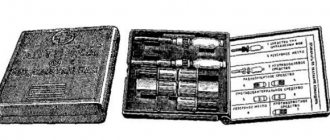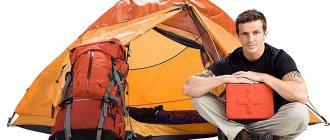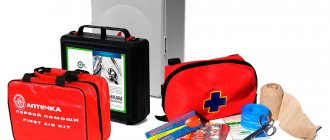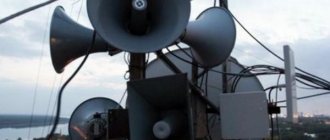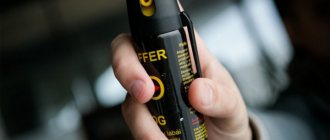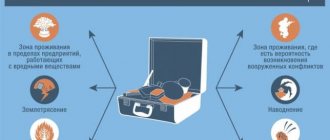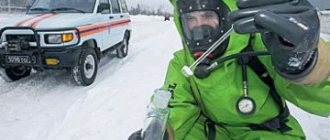Table-1: Contents and purpose of the personal first aid kit AI-2
| No. Section Name Quantity | Compound | Purpose | Application |
| Section No. 1: One syringe tube with a white cap | Promedol | Powerful analgesic for fractures and severe wounds | For pain relief - intramuscular injection |
| Section No. 2: One pencil case with a red cap - 6TB. 0.3 g each | Taren | In case of poisoning with organophosphorus poisons | If there is a risk of poisoning, take 1 tablet, the next tablet after 5 hours |
| Section No. 3: One large colorless pencil case - 15 tablets | Sulfa-dimethoxine | For stomach upset after radiation exposure | The first dose is 7 tablets, the next day - 4 tablets |
| Section No. 4: Two octagonal red pencil cases - 12 tablets | Cystamine | Radioprotective agent No. 1, applied before exposure to radiation | You should take 6 tablets once, 30-60 minutes before possible irradiation |
| Section No. 5: Two tetrahedral colorless pencil cases - 10 tablets | Chlorine-tetracycline | Antibacterial agent Use for wounds, prevention of infection | You should drink 5tb once; After 6 hours, take 5 tablets again |
| Section No. 6: White tetrahedral longitudinal pencil case – 10 tab. | Potassium iodide | Radioprotective agent No. 2, used in case of accidents at nuclear power plants or radioactive contamination of the area | Take 1 tablet. once a day for 10 days. |
| Section No. 7: Blue pencil case with 5 tablets | Etaperazine | Anti-vomiting medicine | In case of concussion, accompanying for uncontrollable vomiting, take 1 tablet every 3-4 hours |
Individual first aid kit AI-2
An individual first aid kit is a set of medical self-help equipment for a serviceman.
The first aid kit is designed to provide self- and mutual assistance, prevent or mitigate the damaging effects of radiation substances (RS), bacterial agents (BS) and organophosphorus toxic substances (FOB), as well as to provide first aid for mechanical and thermal injuries to personnel.
The first aid kit contains a set of medical supplies, distributed into slots in a plastic box.
The size of the box is 90x100x20 mm, the weight of AI-2 is 130 g.
The size and shape of the box allows you to carry it in your pocket, the pocket of a gas mask bag and always have it with you.
Each medicine in the medicine cabinet is located in a strictly defined place; the order of placement is indicated on the inside of the lid.
Composition of the personal first aid kit AI-2
In slot 1, in a syringe tube with a white cap, there is an analgesic (promedol).
It is used for bone fractures, extensive wounds and burns, as an anti-shock agent, by injection into the soft tissue of the thigh or arm. The injection can be given through clothing.
In slot 2, in a red round pencil case with four semi-oval protrusions on the body, there is a means for preventing poisoning by organophosphorus toxic substances (taren antidote), 6 tablets of 0.3 g each.
If there is a threat of poisoning, take an antidote (one tablet), and then put on a gas mask.
If signs of poisoning appear and increase (deterioration of vision, sudden shortness of breath), you should take another tablet. Repeated use is recommended no earlier than after 5-6 hours.
In slot 3, in a large round pencil case without coloring, there is antibacterial agent 2 (sulfadimethoxine), 15 tablets of 0.2 g each. The drug should be used for gastrointestinal disorders that occur after radiation damage. On the first day, take 7 tablets (in one dose), and in the next two days - 4 tablets. This drug is a means of preventing infectious diseases that may arise due to the weakening of the protective abilities of the irradiated organism.
In slot 4, in two pink octagonal pencil cases, there is radioprotective agent No. 1 (cystamine), 12 tablets of 0.2 g each. Take it for personal prophylaxis in case of threat of radiation damage, 6 tablets immediately and preferably 30-60 minutes before irradiation.
In slot 5, in two tetrahedral pencil cases without painting, there is antibacterial agent No. 1 - a broad-spectrum antibiotic (chlortetracycline hydrochloride), 10 tablets of 1,000,000 units each. It is taken as a means of emergency prevention in case of threat of infection by bacterial agents or in case of infection by them, as well as in case of wounds and burns (to prevent infection). First, take the contents of one pencil case - 5 tablets at once, and then after 6 hours take the contents of another pencil case - also 5 tablets.
In slot 6, in a white tetrahedral pencil case with longitudinal semi-oval cutouts in the walls of the edges, there is radioprotective agent No. 2 (potassium iodide), 10 tablets. The drug should be taken one tablet daily for 10 days after a nuclear power plant accident and if a person eats food from an area contaminated with radioactive substances. The drug prevents the deposition of radioactive iodine in the thyroid gland, which enters the body from the external environment.
In slot 7, in a blue round pencil case with six longitudinal protruding stripes, there is an antiemetic agent (etaperazine), 5 tablets of 0.004 g each. Take 1 tablet for head bruises, concussions and contusions, as well as immediately after radiation exposure to prevent vomiting. If nausea continues, take one tablet every 3-4 hours.
During the cold season, it is recommended to carry an AI first aid kit in the chest pocket of your uniform to prevent freezing of liquid medicines.
The medicines contained in the first aid kit are used depending on the indications, both as directed by the commander (senior), and independently in accordance with the instructions that are communicated to the personnel before performing a combat mission.
The following medications are used independently, if indicated: - a remedy for poisoning with FOV - at the first signs of damage; - analgesic - for injuries and burns accompanied by severe pain; - antibacterial agent - for wounds and burns; antiemetic - for nausea caused by exposure to ionizing radiation, as well as contusions and other factors. Only at the command (instruction) of the commander is used: - radioprotective agent; - antibacterial agent - in case of danger of infection by pathogens of infectious diseases; - a prophylactic against poisoning with FOV (tablets) - in anticipation of the sudden use of chemical weapons by the enemy; - antiemetic - in anticipation of exposure to radiation in large doses. — The established dosages of medications must be strictly observed to avoid a decrease in their effectiveness or negative effects on the body. For this purpose, first aid kits contain syringe tubes.
Rules for using a syringe tube
— Take the syringe tube from the first aid kit and, holding it in one hand, grasp the ribbed rim with the other.
— Using a rotating motion, vigorously push the bezel until it stops, and then remove the cap protecting the needle.
— Without touching the needle with your hands, inject it into the soft tissue of the thigh in the upper third from the outside (you can through clothing).
- Squeezing the tube tightly with your fingers, squeeze out the contents and remove the needle without unclenching your fingers.
— A remedy for poisoning with FOV — the contents of one syringe tube with a red cap should be used at the first signs of damage: blurred vision, difficulty breathing, drooling. The earlier the antidote is applied, the higher its effectiveness. Use the second syringe tube with a red cap 5-7 minutes after administering the contents of the first syringe tube in cases where the signs of damage continue to grow (intensify).
Syringe tube
In order to provide mutual assistance in case of severe lesions, accompanied by severe difficulty breathing, convulsions, loss of consciousness, administer the medicine from two syringe tubes at once.
An anti-pain remedy from a syringe tube with a white cap should be used for severe pain caused by fractures, extensive wounds, crushed tissue and burns.
Used syringe tubes must be pinned to the clothes on the chest of the affected person to record the amount of antidote administered when carrying out further treatment measures.
When using an antidote, it is necessary to strengthen control over one’s own condition and the condition of other military personnel, especially when performing combat missions at night, during monotonous activities and elevated ambient temperatures.
To prevent side effects and disturbances in heat exchange that may occur when using the drug for poisoning with OPV, these antidotes should be administered only when there are the first signs of damage to OPV.
Table-2: Composition and detailed description of protective equipment Personal first aid kit AI-2
| Compound | Start of action of the product | Duration of action | Side effects of the drug | Mechanism of action of the product |
| Promedol | Effect 10-15 minutes after injection | About 4 hours | Possible confusion, vomiting, decreased muscle strength | Exc. opioid receptors |
| Taren | Effect in 20 minutes | About 5 o'clock | Glaucoma, kidney and liver dysfunction | M and N-anticholinergic agent |
| Sulfa-dimethoxine | The effect begins in 30-60 minutes | The effect lasts about 1-2 days | Allergic reactions, vomiting, diarrhea, hepatitis | Blocks the synthesis of tetrahydrofolic acid |
| Cystamine | The onset of effect is usually 30 minutes after administration | About 5 o'clock | Burning sensation in the epigastric region, vomiting, drop in blood pressure | Neutralization of free radicals |
| Chlorine-tetracycline | The effect begins 1-2 hours after administration | About 6 o'clock | Stomach pain, diarrhea, vomiting, hypersensitivity reactions | Prevents the formation of the RNA + ribosome complex |
| Potassium iodide | The effect begins within the first day after administration | The effect lasts throughout the entire course of treatment | In rare cases, hypersensitivity reactions are possible | Prevents radioactive iodine deposition |
| Etaperazine | In the first two hours | Lasts up to 9 hours | Possible hypersensitivity reactions (allergy), coordination disorder | Dopamine receptor blocker |
Download a detailed description of the protective equipment of the personal first aid kit AI-2 in the form of a table:
INDIVIDUAL FIRST KIT AI-2 DETAILED TABLE WITH DESCRIPTION AND APPLICATION 1 file(s) 41.00 KB
Download
At the moment, the first aid kit has no practical use. Production and use of AI-2 has been discontinued in the Russian Federation since 2012.
SEE ALSO:
INDIVIDUAL FIRST KIT AI-1 and AI-1M
INDIVIDUAL FIRST KIT AI-3 1BC
INDIVIDUAL FIRST KIT AI-3 2SP
INDIVIDUAL FIRST KIT AI-4
ARMY MILITARY FIRST KIT INDIVIDUAL
KIMGZ FIRST KIT - INDIVIDUAL MEDICAL CIVIL PROTECTION KIT
Composition of a military first aid kit
Go ahead. Let's turn to our military comrades for experience. The well-known individual first aid kit (“AI”) in an orange box. The current version is AI-4 (description on the official website).
Designed to provide assistance in the event of a weapon of mass destruction and injury. Not relevant for hiking - the average tourist is unlikely to need radioprotective and antioxidant agents.
We study group military first aid kits and select approximately similar purposes. We discover one of the analogues: a group first aid kit MNM (“Route Wearable Small Stowage”) for 5-12 people. Used to equip tourist and military groups traveling along wilderness routes and likely to be injured.
The MNM first aid kit contains medical supplies and drugs to help with:
- wounds and general injuries,
- shock and heart disease,
- stress reactions and fainting,
- poisonings and infections,
- other harmful influences.
New items in the MNM first aid kit include: dressing bags, cooling bag containers, a mouth-barrier-mouth device, and an anti-shock kit. It is not advisable to replenish a first aid kit with these items.
We got acquainted with the opinion of Russian specialists, let’s see what they think about completing first aid kits abroad.
Table-2: Action and side effects of protective equipment Personal first aid kit AI-1 USSR
| Compound | Start of action | Time of action | Side effects | Mechanism of action |
| Athens | The first minutes after IM administration | About 8 o'clock | Deterioration of vision, temporary memory loss, dry mouth, loss of coordination, increased heart rate, increased body temperature | Reversible blockade of cholinergic receptors, release of dopamine and norepinephrine |
| Promedol (Omnopon) | 10-20 minutes after IM administration | 3-4 hours | Rare: nausea, muscle weakness, dizziness | μ-(mu) opioid receptor agonist |
| Cystamine | 10-30 minutes after ingestion | 5 o'clock | Feeling of stomach discomfort, heartburn, nausea, low blood pressure | Binds free radicals |
| Tetracycline hydrochloride (Vibromycin) | Maximum effect - 2 hours after administration | 8 ocloc'k | Nausea, vomiting, abdominal pain, upset stomach, allergic reactions | Blocks binding between RNA and the ribosome of the infectious agent |
| Antidote P-6 Taren (Aprofen) | 20-30 minutes after administration | 4-5 hours | Dry mouth, increased intraocular pressure, renal and hepatic colic | Blocks m- and n-cholinergic receptors |
| Potassium iodide | The effect develops gradually during the first 24 hours, the maximum effect occurs after 10 days of regular use. | Within 24-36 hours | Allergic reactions | Competes with radioactive iodine |
| Etaperazine | 2 hours after administration | 9-12 hours | Loss of coordination, allergic reactions | blockade of d2-dopamine receptors |
Download the full table describing AI-1 protective equipment:
INDIVIDUAL FIRST KIT AI-1 DETAILED TABLE WITH DESCRIPTION AND APPLICATION 1 file(s) 291.30 KB
Download
The complete set of the AI-1M first aid kit, in addition to the above composition of protective equipment, is supplemented with the following items:
- one pencil case - FOV P-10M product for the prevention of poisoning
- 2 ampoules of antiseptic - iodine solution 5%
- one pencil case - water disinfectant Pantocid
